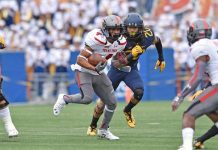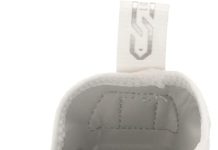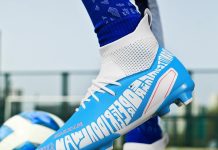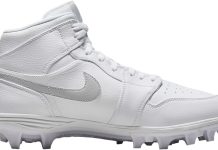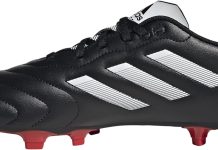If you’re a soccer enthusiast or athlete, you may have found yourself pondering the difference between turf and grass soccer cleats. Understanding the distinction between these two types of specialized footwear is crucial in optimizing your performance on the field. In this article, we will explore the unique characteristics of turf and grass soccer cleats, highlighting their key differences, and helping you make an informed decision when choosing the perfect pair for your game. Let’s lace up and uncover the factors that set these cleats apart!
Turf Soccer Cleats
Turf soccer cleats are specifically designed footwear used for playing soccer on artificial turf surfaces. The purpose of these cleats is to provide players with optimal performance and traction on turf, allowing them to make quick and agile movements on the field.
Review contents
Design Features of Turf Soccer Cleats
Turf soccer cleats have distinctive design features that set them apart from other types of soccer shoes. These cleats typically have a shorter and denser stud arrangement on the outsole, which helps to distribute weight and provide efficient traction on turf. The outsole of turf cleats is made of durable rubber or synthetic materials, designed to withstand the abrasiveness of artificial turf surfaces. Additionally, the upper of turf cleats is often made of lightweight and flexible materials, allowing for enhanced maneuverability and comfort.
Advantages of Turf Soccer Cleats
Turf soccer cleats offer several advantages for players. Firstly, their shorter stud arrangement provides excellent grip and stability on artificial turf, minimizing the risk of slipping or sliding during quick movements. The dense stud pattern also ensures consistent traction, allowing players to make sharp turns and sudden stops without sacrificing control. Additionally, turf cleats are generally more affordable compared to other types of soccer cleats, making them a popular choice for players on a budget.
Disadvantages of Turf Soccer Cleats
While turf soccer cleats provide numerous benefits, they also have some limitations. One major disadvantage is that they are not suitable for use on natural grass surfaces. The shorter and denser studs can easily get stuck in the ground when used on grass, causing discomfort and potentially leading to injury. Additionally, turf cleats may lack the same level of cushioning and support as cleats designed for other playing surfaces, which could impact player comfort during extended periods of play.
Grass Soccer Cleats
Grass soccer cleats, as the name suggests, are designed for playing on natural grass fields. These cleats are specifically engineered to provide players with optimal performance and traction on grass surfaces, ensuring stability and control during gameplay.
Design Features of Grass Soccer Cleats
Grass soccer cleats have distinct design features that make them suitable for use on natural grass. These cleats typically feature longer and more widely spaced studs on the outsole. The longer studs penetrate the surface of the grass, providing excellent grip and traction. The outsole of grass cleats is often made of durable materials such as rubber or thermoplastic polyurethane (TPU) to withstand the rigors of the natural grass field. The upper of grass cleats is typically made of high-quality leather or synthetic materials to provide both comfort and durability.
Advantages of Grass Soccer Cleats
Grass soccer cleats offer several advantages to players. The longer and more widely spaced studs on the outsole provide superior traction on natural grass surfaces, allowing players to have enhanced stability and maneuverability. These cleats also offer excellent shock absorption, which helps to minimize the impact on players’ joints during high-intensity movements. Grass cleats are generally designed with more cushioning and support to provide maximum comfort and protection during extended periods of play.
Disadvantages of Grass Soccer Cleats
Despite their advantages, grass soccer cleats also have some limitations. One major disadvantage is that they are not suitable for use on artificial turf surfaces or hard ground. The longer studs can get stuck in the artificial turf, causing discomfort and restricting freedom of movement. Additionally, grass cleats may be less durable compared to turf cleats, as the longer studs can wear down more quickly when used on harder surfaces or rough playing conditions.
Key Differences
While both turf and grass soccer cleats serve the same purpose of enhancing performance on different playing surfaces, there are distinct differences between the two types of cleats. These differences can significantly impact a player’s performance and overall experience on the field.
Playing Surface
The primary difference between turf and grass soccer cleats lies in the playing surface they are designed for. Turf cleats are specifically designed for artificial turf fields, while grass cleats are intended for natural grass fields. Using the wrong type of cleats on the respective playing surfaces can lead to discomfort, decreased performance, and potential injury.
Outsole Design
The design of the outsole is another crucial difference between turf and grass soccer cleats. Turf cleats have a shorter and denser stud arrangement to provide optimal traction on the relatively flat and abrasive turf surface. On the other hand, grass cleats feature longer, more widely spaced studs that penetrate the grass for enhanced grip and stability.
Studs and Traction
The type and arrangement of studs play a significant role in the traction provided by soccer cleats. Turf cleats generally have rubber or synthetic studs that are shorter and closely spaced. In contrast, grass cleats often feature molded plastic or metal studs that are longer and more widely spaced. The design of the studs determines the grip and traction on a particular surface, ensuring that players can make quick and agile movements without slipping or losing stability.
Support and Stability
Support and stability are critical aspects of any soccer cleat. Turf cleats, being designed for artificial turf, often have a flatter outsole, providing more stability on the even surface. Grass cleats, on the other hand, have a more pronounced arch and curved outsole to accommodate the irregularities of natural grass fields. These design features provide additional support and stability, helping players maintain balance and reduce the risk of ankle injuries.
Comfort and Fit
Comfort and fit are essential for any athlete, and soccer cleats are no exception. Turf cleats are often lighter and more flexible, allowing for greater maneuverability and agility. Grass cleats, on the other hand, often prioritize cushioning and support for comfort during extended periods of play. The materials used in the upper, such as leather or synthetic fabrics, greatly impact the overall comfort and fit of the cleats.
When to Use Turf Soccer Cleats
Turf soccer cleats are the ideal choice in specific situations and playing conditions. Understanding when to use turf cleats can significantly enhance a player’s performance and overall experience on the field.
Artificial Turf Fields
Turf soccer cleats are specifically designed for playing on artificial turf fields. These fields have a relatively flat and abrasive surface, which can wear down other types of cleats more quickly. Turf cleats provide excellent traction on these surfaces, allowing players to make quick movements and change direction without sacrificing control. Using turf cleats on artificial turf fields ensures optimal performance and minimizes the risk of slipping or sliding.
Hard Ground Surfaces
In addition to artificial turf fields, turf soccer cleats are also suitable for hard ground surfaces. These surfaces include dry, compacted dirt, or even concrete. The shorter and denser stud arrangement of turf cleats provides the necessary traction and stability on these hard surfaces, allowing players to maintain control and balance during gameplay.
Dry Weather Conditions
Turf soccer cleats are particularly effective in dry weather conditions, where the artificial turf field remains firm and less slippery. The combination of the outsole design and traction provided by turf cleats ensures that players can move with confidence and perform at their best, even in dry, dusty conditions.
When to Use Grass Soccer Cleats
Grass soccer cleats are specifically designed for playing on natural grass fields. Knowing when to use grass cleats ensures optimal performance and comfort on the field.
Natural Grass Fields
Grass soccer cleats are the ideal choice for playing on natural grass fields. The longer and more widely spaced studs on grass cleats penetrate the surface of the grass, providing excellent traction and grip. Playing with grass cleats on natural grass enhances stability, control, and maneuverability, allowing players to make sharp turns and sudden stops without the risk of slipping.
Soft or Wet Ground Surfaces
Grass cleats are particularly effective on soft or wet ground surfaces. The longer studs provide superior grip and prevent sinking into the ground, ensuring stability and preventing slips during gameplay. In wet conditions, the waterlogged grass can become slippery, but grass cleats with their stud design offer better traction and minimize the risk of losing footing.
Rainy Weather Conditions
Playing in rainy weather conditions requires specific footwear, and grass soccer cleats are a suitable choice. The longer studs of grass cleats help to dig into the wet ground and provide traction even on muddy or rain-soaked fields. The design features of grass cleats ensure that players can maintain control, stability, and agility during gameplay, even in adverse weather conditions.
Comparing Durability
The durability of soccer cleats is an important factor for players to consider, as it can impact both performance and longevity. Here, we compare the durability of turf and grass soccer cleats.
Durability of Turf Soccer Cleats
Turf soccer cleats are generally more durable compared to grass cleats. The outsole of turf cleats is typically made of rubber or durable synthetic materials that can withstand the abrasive nature of artificial turf surfaces. Furthermore, the shorter stud arrangement reduces the wear and tear on the cleats, as they are less prone to getting stuck in the ground. With proper care and maintenance, turf cleats can last for multiple seasons.
Durability of Grass Soccer Cleats
Grass soccer cleats are generally less durable compared to their turf counterparts. The longer studs on grass cleats are subjected to greater stress and can wear down more quickly, particularly on harder ground surfaces. Additionally, the natural grass field can introduce moisture, which may affect the lifespan of the cleats. Regular cleaning and proper care can help extend the durability of grass cleats, but they may need to be replaced more frequently compared to turf cleats.
Factors Affecting Cleat Longevity
Several factors can influence the longevity of soccer cleats, regardless of the playing surface. The frequency and intensity of use, the quality of the materials used, and the player’s individual playing style can all impact how long the cleats last. Taking care of cleats by cleaning them after each use, allowing them to dry naturally, and storing them in a well-ventilated area can help extend their lifespan.
Choosing the Right Cleats
Choosing the right soccer cleats can significantly enhance a player’s performance and overall experience on the field. Considering the following factors can guide players in making the best cleat selection for their needs.
Consideration of Playing Surface
The choice of cleats should be based on the playing surface. It is essential to match the cleats with the specific surface the player will be playing on. Turf cleats are suitable for artificial turf fields and hard ground surfaces, while grass cleats are designed for natural grass fields. Using the wrong type of cleats can lead to discomfort, decreased performance, and potential injury.
Player Position and Style of Play
The position a player plays and their style of play should also be taken into account when choosing cleats. For example, forwards and attacking players may prefer cleats that offer more traction and agility, allowing for quick bursts of speed. Defenders, on the other hand, may prioritize cleats that provide stability and support for better tackling and positional play. Midfielders may require a balance between agility and stability. Understanding one’s playing style and position can help in selecting cleats that cater to specific needs.
Comfort and Fit
Comfort and fit should never be compromised when selecting soccer cleats. It is crucial to try on different cleats and find the ones that provide a snug yet comfortable fit. Cleats that are too tight can cause discomfort and potentially lead to foot injuries, while cleats that are too loose may impact control and stability on the field. Additionally, considering the materials used in the upper can greatly impact the overall comfort and fit of the cleats.
Cleat Maintenance and Care
Proper care and maintenance of soccer cleats are essential to maximize their lifespan and performance. Regularly cleaning cleats after each use, removing excess dirt, and allowing them to dry naturally can help prevent deterioration. It is also recommended to store cleats in a well-ventilated area to avoid odors and mold growth. Taking proper care of cleats can not only extend their durability but also ensure optimal performance on the field.
Popular Brands and Models
Several brands and models of soccer cleats have gained popularity among players and are well-regarded for their performance, durability, and comfort. These brands offer a wide range of options to cater to different playing styles, preferences, and budgets.
Top Turf Soccer Cleat Brands and Models
Some of the top turf soccer cleat brands and models include Adidas Copa Mundial, Nike Mercurial Victory, Puma Future Z, and New Balance Furon. These brands are known for their innovative designs, superb traction on turf surfaces, and high-quality construction.
Top Grass Soccer Cleat Brands and Models
Popular grass soccer cleat brands and models include Nike Tiempo Legend, Adidas Predator Mutator, Puma One, and Under Armour Magnetico. These brands are renowned for their superior grip on grass fields, exceptional comfort, and durability.
Features and Reviews
Each brand and model of soccer cleats offers unique features and benefits. It is important for players to read reviews and understand the specific characteristics of different cleats before making a purchase. Online retailers, sports magazines, or even fellow players can provide valuable insights and recommendations to help players make an informed decision.
Price Range
The price range of soccer cleats can vary significantly depending on the brand, model, and features offered. Considering the following factors can help determine the overall cost of soccer cleats.
Turf Soccer Cleat Price Range
Turf soccer cleats generally have a wide price range, depending on the brand and the specific features offered. Entry-level turf cleats can range from $50 to $100, while high-end professional-grade cleats can cost upwards of $200. The price variation reflects the quality of materials, technology, and performance features incorporated into the cleats.
Grass Soccer Cleat Price Range
Similar to turf cleats, the price range of grass soccer cleats can vary significantly. Entry-level grass cleats usually start around $50 and can go up to $150 for more advanced models. High-end professional-grade grass cleats can exceed $200. The price variation is influenced by the brand reputation, materials used, and technological advancements incorporated into the cleats.
Factors Affecting Price
Several factors contribute to the price variation of soccer cleats. The reputation and popularity of the brand, the use of high-quality materials, advanced technologies, and innovative features all have a significant influence on the overall cost. Additionally, limited edition or endorsed cleats by professional players may have a higher price tag due to their exclusivity.
Conclusion
Choosing the right soccer cleats is essential for optimal performance and comfort on the field. The differences between turf and grass soccer cleats, such as playing surface, outsole design, studs and traction, support and stability, and comfort and fit, should be carefully considered. Understanding when to use each type of cleat, based on field conditions and weather, ensures maximum performance and reduces the risk of injuries. Factors like durability, player position, playing style, comfort and fit, and cleat maintenance should also be taken into account when selecting the right cleats. Researching and considering popular brands and models, along with price range, can assist players in making an informed decision. By understanding the differences and selecting cleats that match their specific needs, players can optimize their performance and enjoy the game to the fullest.





